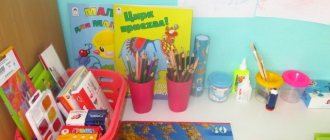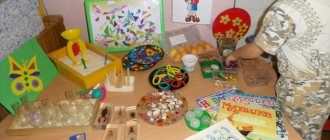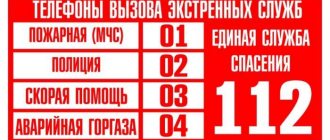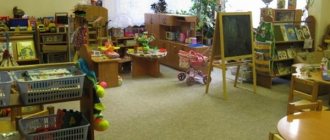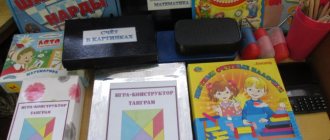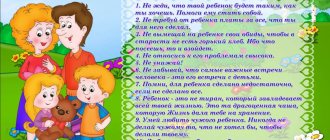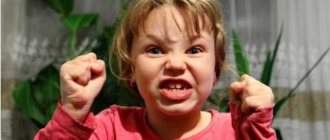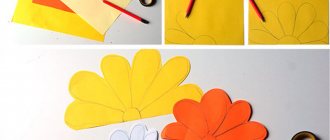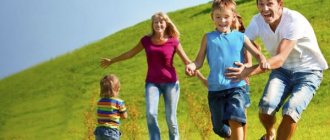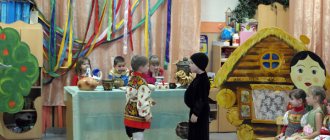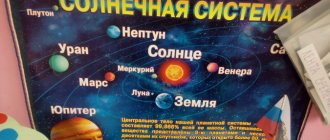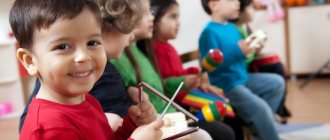The purpose and objectives of the sports ground in kindergarten
The main goal of the physical zone is to introduce preschool children to a healthy lifestyle and stop their craving for movement. This need is natural for kindergarteners, so the task of the mentor is to promote their physical education. Teach children how to properly use gym equipment in kindergarten and how to move safely in a limited area.
Objectives of the sports zone in kindergarten
The main task of a gym in a kindergarten is to organize optimal conditions for active pastime and acquiring the physical fitness desired for a particular age. The corner’s tasks also include:
- introducing children to sports;
- prevention of dysfunctions of the musculoskeletal system;
- polishing motor functions.
Below is a table that outlines the tasks of the sports zone based on the age of the children.
| Age group | Tasks |
| Junior (up to 4 years old) |
|
| Medium (4 to 5 years) |
|
| Senior (from 5 years old) |
|
| Preschool (from 6 to 7 years old) |
|
The design of the physical education area should directly resonate with its objectives for each age group. And the complete physical development of children depends on its equipping with sports equipment for kindergarten.
Work in the physical education corner.
⇐ PreviousPage 2 of 21Next ⇒Tasks. Continue to introduce children to movement techniques when using the attributes of a physical education corner. Teach children to jump over a rotating rope: discuss safety rules, introduce the technique of performing the jump.
No. 3. Preliminary work for the role-playing game “Family”: conversation about how children help their mother; children writing stories about their mothers; reading N. Nosov’s story “Patch”; didactic game "Let's cook lunch."
Tasks. Contribute to enriching a familiar game with new solutions (participation of an adult, changing attributes, introducing substitute items or introducing a new role). Create conditions for creative self-expression, for the emergence of new games and their development.
Listening to musical works: W. Mozart “Minuet”.
Tasks. Teach children to distinguish shades of mood conveyed by music, the form of a piece of music, teach them to convey the character of music in movements.
No. 5. Work in the music education corner : introduction to the Russian folk vole “Cornflower”.
Tasks. Teach children to play as part of an ensemble, simultaneously begin and end the melody, observe the general dynamics and tempo.
No. 6. Introduction to fiction: poem by A.S. Pushkin "Winter Evening".
Tasks. Teach children to understand, highlight and reproduce figurative expressions from the text in their speech. Instill a love for the poetic word, develop imagination.
Individual work in fine arts: drawing “My still life”.
Tasks. Teach children to correctly place objects on a sheet of paper-i and use cold and warm colors. Develop imagination, the ability to convey ideas and emotions using brushes and paints.
Theatrical game “Three Spikelets”.
Tasks. Teach children to choose and use means of expressive speech, movement and facial expressions in accordance with the characters and the development of the plot.
Day 2
Morning
Activities
Conversation on the topic “Forests of Russia”.
Tasks. Expand children's understanding of the types of forests (deciduous: birch grove, oak grove; coniferous: pine forest, spruce forest; mixed forests). Learn to name a forest by its predominant plant species, introduce the inhabitants of various forests.
No. 2. Individual work in fine arts : we learn to draw according to our impressions “What I saw on the way to kindergarten.”
Tasks. Teach children to convey in drawings similarities with real objects, to reflect their impressions, emotional attitude towards what is depicted.
⇐ Previous2Next ⇒
Site search:
Requirements for the design of a sports corner in a kindergarten
When developing the layout of a sports ground, you need to remember that children of preschool age will be playing on it. Therefore, the corner for sports equipment must comply with the following rules:
- Safety The sports corner should be located in a safe place, away from fragile, sharp or heavy objects. Sports equipment should also be environmentally friendly and safe.
- Optimal placement It is better to divide the gym into zones according to the physical elements. This will help save a lot of space. And sports equipment should be placed so that it does not interfere with the motor activity of children. The corner in the group should be located next to the play area and the place of theatrical activities.
- Ease of use All equipment for exercises and games should be freely accessible, based on the age of the children, their gender and interests.
- Aesthetic design The physical development center in the garden should be aesthetically designed. It would be better if it was bright sports equipment. This design will attract attention and encourage action. It would be ideal to design the physical education area in the same style as other development sectors of the group.
- Testing All equipment must be subject to a load test and visual inspection.
Important! When developing a project for a sports complex for a kindergarten, you need to pay attention to its size. According to standards, each child must have at least one square meter of space.
Even more information about the requirements and design features of a sports zone in the following video:
Equipment for the physical training area
To ensure that preschool children’s sports activities are as active and useful as possible, you need to properly distribute the equipment. Convenient placement of sports equipment allows children to easily approach them without interfering with each other.
Important! To maintain interest among kindergarteners, you can periodically change the location of the equipment.
Modern equipment for a sports ground may contain the following list of sports furniture and equipment:
- Swedish wall;
- gymnastic benches;
- rope ladder; rope ladder and other attachments;
- a special place for storing equipment - jump ropes, hoops, balls, relay batons, etc.;
- soft modules and trampolines;
- plastic slide;
- dry pool;
- orthopedic rugs and tracks;
- gymnastic mats;
- regular and massage balls, rings and rollers, jump ropes and sandbags and other small dispensing equipment;
- football goals and so on.
All this equipment should be used taking into account the age group of children. For example, if a dry pool is suitable for children, then soft modules are suitable for older kindergarteners. As the children's interests expand, the corner can be replenished with more complex equipment.
Brief description of the main sports equipment
The main characteristics of gym equipment are shown in the table.
| Equipment | Characteristic |
| Swedish wall | Typically, sections are located around the perimeter of the entire gym. Their optimal number is from 4 to 6. The height of the sections should be no more than 2.5 meters, and the distance between the crossbars should be from 20-22 and 30-40 cm. It’s good if the wall is equipped with additional equipment - a rope ladder, trapeze, rope, rings, etc. It is imperative to place a gymnastic mat near the wall bars. |
| Benches | Benches should be smooth, without cracks or snags. They should also not be slippery. The height of the benches can be 20, 25,30 cm, and the length is 3 meters. |
| Soft modules, trampoline, mats | Choose equipment with good padding to avoid injuries. Stick to models in bright colors. The modules can be used as building material, arches and obstacles. |
| Orthopedic mats and tracks | Important elements for preventing flat feet and training your feet. The path may contain small parts, hard and soft elements. |
Features of equipment for the younger group
For kids, it is better to design the corner as one of the parts of a large play area. Rolling toys, balls of different sizes, cubes, tambourines, and walking slides should prevail here. Children, being in constant motion, must use the available equipment and toys at their own discretion.
Of great interest to younger preschoolers are masks for games, presented in the form of fairy-tale characters. They can be successfully used in sports exercises and games.
The video shows an example of the design of a physical education area for children:
How best to decorate a corner in the middle group
Supplement the physical education area with albums on introducing different sports. Sports equipment here is formed based on subgroups of children who already organize their own sports leisure activities. Games such as darts, skittles, and towns should be freely available. Details about the design of a corner for children under 5 years old are shown in the video:
What to pay attention to when designing a sports corner in the senior group
For older kindergarteners, it is reasonable to create a complex atmosphere for performing different types of physical education elements. It is also important to introduce children to key episodes in the sporting life of the country and city. In addition to a variety of sports equipment, the corner in the senior group should be supplemented with schemes for conducting different games, according to which the children themselves will be able to play any game. The sports area should be actively used during the day, both together with the teacher and individually. An excellent addition to the physical education area for the older group will be a Swedish wall with rings and a rope. What else can be equipped with a sports corner in a kindergarten, see the video:
Master class “Organization of a physical education corner in the senior group”
Master Class
Organization of a physical activity center in the senior group “Kolobok”
“To make a child smart and sensible, make him strong and healthy: let him work, act, run, scream, let him be in constant motion.”
Jean Jacques Rousseau
The main goal of the physical education corner:
- The physical education corner serves to satisfy the preschooler’s need for movement and introduce him to a healthy lifestyle.
Objectives of the physical education corner:
- development of movements and improvement of motor functions;
- achieving age-appropriate physical fitness;
- prevention of musculoskeletal disorders;
- creating favorable conditions for active recreation, joyful, meaningful activities in collective games and entertainment;
- introducing children to physical education and sports
The teacher's task:
- To teach children independent motor activity in confined spaces and the correct use of physical education equipment.
Requirements for a sports corner
1. Safety of placement: the sports corner should not be placed next to windows, a corner of nature or an area for children’s independent artistic activities. It can be placed: in a reception room, group room or bedroom.
2. Meet hygienic and pedagogical requirements, and the location must comply with the principle of expediency.
3. The corner should logically fit into the interior of the room and be aesthetically designed.
4. The corner should be accessible for use by every child.
5. The corner must correspond to the age of the children and the requirements of the program, taking into account the interests of both boys and girls.
6. The presence of symbols of physical education and sports.
- For older preschoolers, it is advisable to create varied, complicated conditions for performing different types of physical exercises using manuals.
- In older groups, it is necessary to introduce children to the most important events in the sporting life of the country and place relevant material in the corner (illustrations, games, etc.)
- The corner should be actively used during the day (individual work with children, independent activities of children)
Corner equipment Attributes for active and sedentary games: masks, ribbons, handkerchiefs
Attributes for relay games: flags, balls
Massage mats to prevent flat feet
Massage mittens
Skittles for ball rolling exercises
Hitting exercise balls
Hoops and jump ropes for performing and strengthening basic movements
Sandbags for throwing and balance exercises
Height meter for monitoring the anthropometric indicators of children
Non-traditional equipment “Funny Hockey Players” for developing accuracy
Stick, takeaway rackets
Thank you for your attention!
